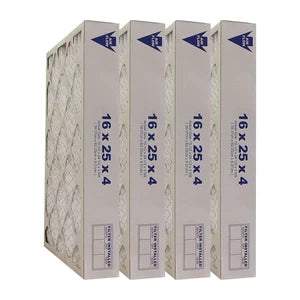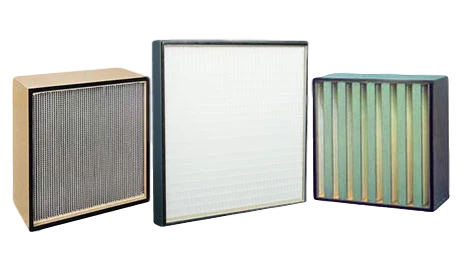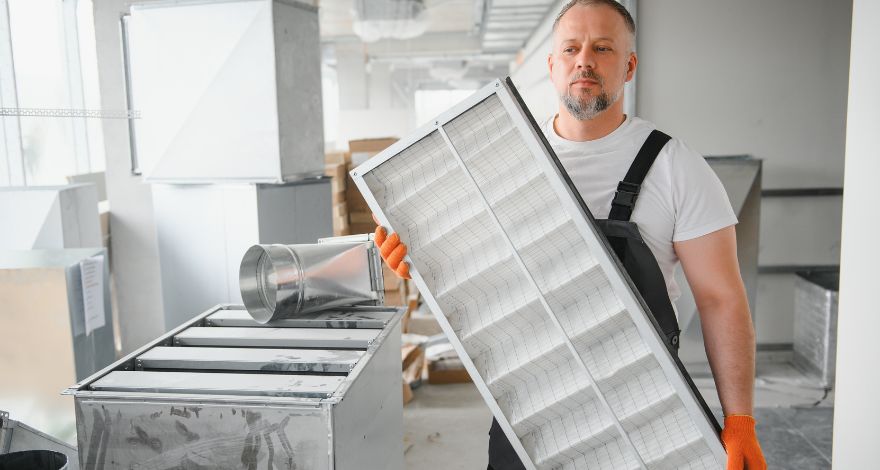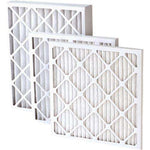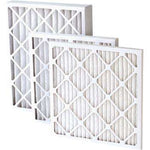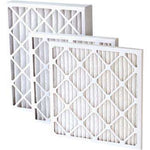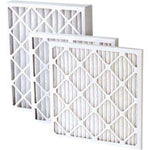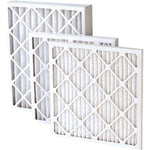You have no items in your shopping cart.
How to Size, Buy, and Replace Geothermal Furnace Filters Easily?
A ground-source heat pump might draw energy from the earth, but the air you breathe still passes through a filter. Geothermal filters do the same job as ordinary furnace pads, as they capture dust before it reaches the coil.
However, they face different airflow loads, off-beat frame dimensions, and deeper cabinets.
In this all-included guide, you'll learn everything there is to know about the role of geothermal furnace filters, why most of them need MERV 11 or MERV 13, and how to measure hard-to-find sizes, like 30x32x2 inches.
Most importantly, we'll tell you the 4 maintenance truths about geothermal filters every homeowner must be aware of. As a bonus, you'll discover where to get the best air filters for furnace in Canada and the US!

Why Do Geothermal Systems Need Special Attention?
A geothermal heat pump features a variable-speed blower that runs longer at lower RPMs. This also means that more total hours of air move across the media.
If the filter leaks or plugs, these three things can happen:
-
Bypass dust can coat the ECM motor and shorten its life.
-
Coil heat transfer can suffer, so loops run hotter and the compressor draws extra power.
-
Indoor air quality (IAQ) drops because the unit rarely shuts off long enough for particles to settle.
Due to these loads, geothermal furnace filters often come in two-inch depths with extra pleated areas. They are also available in oversized face dimensions, like 30x30, 28x34, and the popular 30x32 format.
Geothermal Furnace Filters and Common Sizing Traps
OEM geothermal cabinets often leave barely 3mm of clearance, so it's important to understand nominal versus actual sizes. Usually, 30x32x2 labelled filters measure 29 ¾ × 31 ¾ × 1 ¾. Also, 28x30x1 typically comes in at 27 ½ × 29 ½ × ¾.
For maximum precision, make sure you always measure your current filter.
How to Measure and Order Air Filters for Geothermal Systems?
Getting the most appropriate geothermal air filters is easy once you've measured everything beforehand. Here's what you need to do before you order the most appropriate geothermal furnace filters.
-
Start by shutting off the heat pump.
-
Slide the old pad out flat, and make sure it doesn't bend.
-
Get a ruler and measure the opening width, height, and depth to the nearest 1⁄16 inches.
-
Write down the actual size (such as 29 ¾ × 31 ¾ × 1 ¾).
-
Round up the size to the nearest ⅛.
-
Choose the MERV and pack size; we recommend buying in bulk for more economical shipping.
-
Check out and wait for your order to arrive promptly.
That's it! Order the highest-quality geothermal furnace filters in Canada today!
Choosing the Correct MERV Rating for Geothermal Furnace Filters
Before ordering air filters for geothermal systems, you need to know about MERV ratings and what they mean for your device.
In brief, MERV stands for Minimum Efficiency Reporting Value, and it reports the filter's ability to capture larger particles up to 10 microns. The higher the MERV rating, the better your filter is at trapping different particle types. However, higher numbers aren't always the best fit.
Geothermal blowers already face the resistance of a high-density coil. So, most installers suggest MERV 11 furnace filters to balance capture and airflow. If you want to get MERV 13 due to allergies, make sure the total external static pressure stays below the motor plate limit.

4 Maintenance Truths About Geothermal Filters You Must Know About
Keep these 4 things in mind to ensure your geothermal filters are maintained properly and your device is running effectively to its full capacity.
-
Swap out your filters when it's due time: Variable-speed geothermal blowers move air for far more hours per day than regular furnaces.
So, how often should I change geothermal air filters? Usually, it's recommended to switch out the filter every three months. It's best to do a visual check monthly and stick to a 90-day replacement schedule.
If you burn wood, live near a construction area with heavier pollution, or have pets, a 60-day time frame might be smarter.
-
A clogged pad can steal efficiency almost immediately: Dirty geothermal air filters can drop system efficiency and force variable-speed fans to ramp up. This can raise the watt draw even when the compressor stays steady.
That extra fan energy can show up on your bill before the house feels dusty.
-
Choose the highest MERV your blower can actually handle: Again, higher doesn't always mean better, as too much resistance can cut airflow and shorten the compressor's life.
Usually, geothermal filters with a MERV 11 keep coil surfaces clean without tripping the blower into high-torque mode. However, if you or your family members have allergies, a MERV 13 option could be more suitable.
-
Even pin-sized gaps around the frame undo good filtration: Just a 1mm leak around the media can knock a high-efficiency filter down several MERV points and let dust foul the evaporator coil.
This in turns raises loop temperature and energy use. It's best to push the pad fully home and, if the rack is loose, add a foam gasket so every cubic foot of return air goes through the filter.
Order Discount Furnace Filters
Different sizes, like 30x32x2 geothermal filters, can be expensive. However, it's not always the case, especially when you know where to shop. United Filter, the best source for premier-quality, inexpensive geothermal furnace filters, is here to help you out.
We offer a range of commercial filters, including bag filters, rigid box filters, HEPA filters, and geothermal filters. If you are ready to order, please contact us via phone (905) 403-0160 or send us your details.
The Best Quick Fixes for Common Airflow Complaints
Should you consider quality filters for geothermal surfaces? Yes, especially when you're dealing with issues. Here are some of the most common complaints we hear and some easy fixes.
-
Your room feels stuffy: If your living environment feels unpleasant and stuffy, check that the filter is fully sealed. Any gaps can cause short cycling.
-
The return grille is whistling: You may have upgraded to MERV 13 without deepening the rack. We recommend dropping to MERV 11 or installing a 4-inch housing.
-
High power bills: A dirty filter can raise compressor runtime by a quarter. Swap it out, then clear leaves from the loop manifold strainer.
If you have more questions about filters for geothermal furnaces (or any doubts), please feel free to contact us today. We'll help you find the right size for your device.

Why Choose Our Premium Geothermal Filters?
United Filter offers standard and custom size filters to fit the needs of any household. Most importantly, we offer the highest-quality geothermal furnace filters in Canada and the United States.
Here are some key reasons why you should always order from United Filter.
-
Zero forced fits, as our geothermal filters are cut to the exact actual size.
-
Fast and safe shipping in crush-resistant cartons.
-
30-day return policy (for a full refund or exchange, plus we pay the return shipping costs if the return is a result of our error).
Filters for Geothermal Furnaces: FAQ
What does a geothermal furnace filter do?
Geothermal filters capture dust before it reaches the evaporator coil of a ground-source heat pump. So, they can protect airflow, improve indoor air quality, and ensure proper heat transfer.
Do geothermal systems require a special filter?
Yes, they do. They have variable-speed blowers that run for long periods, so the filter sees more airflow and is often a full 2 inches thick with extra pleats.
What is the best MERV rating?
We usually recommend MERV 11 furnace filters or MERV 13, as they are suitable for most households with allergies and pets. However, make sure your blower can handle the extra resistance of MERV 13.
How often to change geothermal filters?
Check your device monthly and plan on changing the filter every 90 days, or 3 months. If you have pets or live in a more polluted area, you might benefit from a 60-day schedule.
Why is the actual size smaller than the label?
Filters are designed to slide into tight OEM cabinets. For instance, a 30x32x2 label usually measures about 29 ¾ × 31 ¾ × 1 ¾ inches.
What happens if the filter clogs?
A pad that's loaded with dirt and gunk can add up to around 0.3 inches of static pressure. This then forces the blower to ramp up, raising energy use, and cutting the efficiency of the coil.
How does filtration protect loop efficiency?
A ground loop delivers water only a few degrees away from the target temperature. The system relies on a clean evaporator coil and unrestricted airflow to squeeze every bit of heat into, or out of, the airstream. A clogged filter can add 0.2 to 0.3 inches of static pressure.
Where can I get the best air filters for furnace?
You can purchase the best quality furnace filters in Canada from United Filter. Order yours this moment, save money, and enjoy cleaner air in your home.

Geothermal Furnace Filters: Conclusion
Measure carefully, swap geothermal filters on schedule, and your ground-source heat pump will reward you with decades of low-cost comfort.
Reach out to United Filter for high-quality geothermal furnace filters, including the popular 30x32x2 for homeowners across Canada and the United States.
If you are ready to shop premium, dependable geothermal furnace filters, don’t wait and place an order today!
How to Size, Buy, and Replace Geothermal Furnace Filters Easily?
A ground-source heat pump might draw energy from the earth, but the air you breathe still passes through a filter. Geothermal filters do the same job as ordinary furnace pads, as they capture dust before it reaches the coil.
However, they face different airflow loads, off-beat frame dimensions, and deeper cabinets.
In this all-included guide, you'll learn everything there is to know about the role of geothermal furnace filters, why most of them need MERV 11 or MERV 13, and how to measure hard-to-find sizes, like 30x32x2 inches.
Most importantly, we'll tell you the 4 maintenance truths about geothermal filters every homeowner must be aware of. As a bonus, you'll discover where to get the best air filters for furnace in Canada and the US!

Why Do Geothermal Systems Need Special Attention?
A geothermal heat pump features a variable-speed blower that runs longer at lower RPMs. This also means that more total hours of air move across the media.
If the filter leaks or plugs, these three things can happen:
-
Bypass dust can coat the ECM motor and shorten its life.
-
Coil heat transfer can suffer, so loops run hotter and the compressor draws extra power.
-
Indoor air quality (IAQ) drops because the unit rarely shuts off long enough for particles to settle.
Due to these loads, geothermal furnace filters often come in two-inch depths with extra pleated areas. They are also available in oversized face dimensions, like 30x30, 28x34, and the popular 30x32 format.
Geothermal Furnace Filters and Common Sizing Traps
OEM geothermal cabinets often leave barely 3mm of clearance, so it's important to understand nominal versus actual sizes. Usually, 30x32x2 labelled filters measure 29 ¾ × 31 ¾ × 1 ¾. Also, 28x30x1 typically comes in at 27 ½ × 29 ½ × ¾.
For maximum precision, make sure you always measure your current filter.
How to Measure and Order Air Filters for Geothermal Systems?
Getting the most appropriate geothermal air filters is easy once you've measured everything beforehand. Here's what you need to do before you order the most appropriate geothermal furnace filters.
-
Start by shutting off the heat pump.
-
Slide the old pad out flat, and make sure it doesn't bend.
-
Get a ruler and measure the opening width, height, and depth to the nearest 1⁄16 inches.
-
Write down the actual size (such as 29 ¾ × 31 ¾ × 1 ¾).
-
Round up the size to the nearest ⅛.
-
Choose the MERV and pack size; we recommend buying in bulk for more economical shipping.
-
Check out and wait for your order to arrive promptly.
That's it! Order the highest-quality geothermal furnace filters in Canada today!
Choosing the Correct MERV Rating for Geothermal Furnace Filters
Before ordering air filters for geothermal systems, you need to know about MERV ratings and what they mean for your device.
In brief, MERV stands for Minimum Efficiency Reporting Value, and it reports the filter's ability to capture larger particles up to 10 microns. The higher the MERV rating, the better your filter is at trapping different particle types. However, higher numbers aren't always the best fit.
Geothermal blowers already face the resistance of a high-density coil. So, most installers suggest MERV 11 furnace filters to balance capture and airflow. If you want to get MERV 13 due to allergies, make sure the total external static pressure stays below the motor plate limit.

4 Maintenance Truths About Geothermal Filters You Must Know About
Keep these 4 things in mind to ensure your geothermal filters are maintained properly and your device is running effectively to its full capacity.
-
Swap out your filters when it's due time: Variable-speed geothermal blowers move air for far more hours per day than regular furnaces.
So, how often should I change geothermal air filters? Usually, it's recommended to switch out the filter every three months. It's best to do a visual check monthly and stick to a 90-day replacement schedule.
If you burn wood, live near a construction area with heavier pollution, or have pets, a 60-day time frame might be smarter.
-
A clogged pad can steal efficiency almost immediately: Dirty geothermal air filters can drop system efficiency and force variable-speed fans to ramp up. This can raise the watt draw even when the compressor stays steady.
That extra fan energy can show up on your bill before the house feels dusty.
-
Choose the highest MERV your blower can actually handle: Again, higher doesn't always mean better, as too much resistance can cut airflow and shorten the compressor's life.
Usually, geothermal filters with a MERV 11 keep coil surfaces clean without tripping the blower into high-torque mode. However, if you or your family members have allergies, a MERV 13 option could be more suitable.
-
Even pin-sized gaps around the frame undo good filtration: Just a 1mm leak around the media can knock a high-efficiency filter down several MERV points and let dust foul the evaporator coil.
This in turns raises loop temperature and energy use. It's best to push the pad fully home and, if the rack is loose, add a foam gasket so every cubic foot of return air goes through the filter.
Order Discount Furnace Filters
Different sizes, like 30x32x2 geothermal filters, can be expensive. However, it's not always the case, especially when you know where to shop. United Filter, the best source for premier-quality, inexpensive geothermal furnace filters, is here to help you out.
We offer a range of commercial filters, including bag filters, rigid box filters, HEPA filters, and geothermal filters. If you are ready to order, please contact us via phone (905) 403-0160 or send us your details.
The Best Quick Fixes for Common Airflow Complaints
Should you consider quality filters for geothermal surfaces? Yes, especially when you're dealing with issues. Here are some of the most common complaints we hear and some easy fixes.
-
Your room feels stuffy: If your living environment feels unpleasant and stuffy, check that the filter is fully sealed. Any gaps can cause short cycling.
-
The return grille is whistling: You may have upgraded to MERV 13 without deepening the rack. We recommend dropping to MERV 11 or installing a 4-inch housing.
-
High power bills: A dirty filter can raise compressor runtime by a quarter. Swap it out, then clear leaves from the loop manifold strainer.
If you have more questions about filters for geothermal furnaces (or any doubts), please feel free to contact us today. We'll help you find the right size for your device.

Why Choose Our Premium Geothermal Filters?
United Filter offers standard and custom size filters to fit the needs of any household. Most importantly, we offer the highest-quality geothermal furnace filters in Canada and the United States.
Here are some key reasons why you should always order from United Filter.
-
Zero forced fits, as our geothermal filters are cut to the exact actual size.
-
Fast and safe shipping in crush-resistant cartons.
-
30-day return policy (for a full refund or exchange, plus we pay the return shipping costs if the return is a result of our error).
Filters for Geothermal Furnaces: FAQ
What does a geothermal furnace filter do?
Geothermal filters capture dust before it reaches the evaporator coil of a ground-source heat pump. So, they can protect airflow, improve indoor air quality, and ensure proper heat transfer.
Do geothermal systems require a special filter?
Yes, they do. They have variable-speed blowers that run for long periods, so the filter sees more airflow and is often a full 2 inches thick with extra pleats.
What is the best MERV rating?
We usually recommend MERV 11 furnace filters or MERV 13, as they are suitable for most households with allergies and pets. However, make sure your blower can handle the extra resistance of MERV 13.
How often to change geothermal filters?
Check your device monthly and plan on changing the filter every 90 days, or 3 months. If you have pets or live in a more polluted area, you might benefit from a 60-day schedule.
Why is the actual size smaller than the label?
Filters are designed to slide into tight OEM cabinets. For instance, a 30x32x2 label usually measures about 29 ¾ × 31 ¾ × 1 ¾ inches.
What happens if the filter clogs?
A pad that's loaded with dirt and gunk can add up to around 0.3 inches of static pressure. This then forces the blower to ramp up, raising energy use, and cutting the efficiency of the coil.
How does filtration protect loop efficiency?
A ground loop delivers water only a few degrees away from the target temperature. The system relies on a clean evaporator coil and unrestricted airflow to squeeze every bit of heat into, or out of, the airstream. A clogged filter can add 0.2 to 0.3 inches of static pressure.
Where can I get the best air filters for furnace?
You can purchase the best quality furnace filters in Canada from United Filter. Order yours this moment, save money, and enjoy cleaner air in your home.

Geothermal Furnace Filters: Conclusion
Measure carefully, swap geothermal filters on schedule, and your ground-source heat pump will reward you with decades of low-cost comfort.
Reach out to United Filter for high-quality geothermal furnace filters, including the popular 30x32x2 for homeowners across Canada and the United States.
If you are ready to shop premium, dependable geothermal furnace filters, don’t wait and place an order today!
